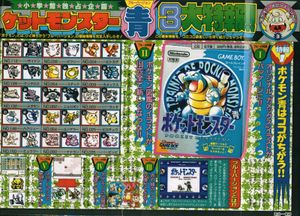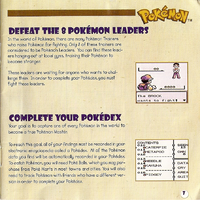Pokémon Red and Blue Versions
- Pokémon Red redirects here. For the Japanese game with the same name, see Pokémon Red and Green Versions.
- Pokémon Blue redirects here. For the Japanese game with the same name, see Pokémon Blue Version (Japanese).
| Pokémon Red Version | |
|---|---|
 Pokémon Red Version's boxart, depicting Charizard | |
| Pokémon Blue Version | |
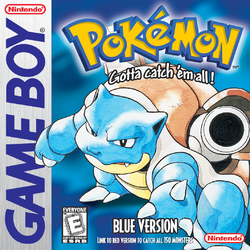 Pokémon Blue Version's boxart, depicting Blastoise | |
Basic info
| |
| Platform: | Game Boy (enhanced for the Super Game Boy) |
| Category: | RPG |
| Players: | 2 players simultaneous |
| Connectivity: | Game Link Cable, wireless (Nintendo 3DS only) |
| Developer: | Game Freak |
| Publisher: | Nintendo |
| Part of: | Generation I core series |
Ratings
| |
| CERO: | Not applicable |
| ESRB: | E |
| ACB: | G |
| OFLC: | G8+ |
| PEGI: | 12 |
| GRAC: | Not applicable |
| GSRR: | N/A |
Release dates
| |
| Japan: | As Red and Green: February 27, 1996 (Game Boy) February 27, 2016 (3DS VC) As Blue: October 15, 1996 (Game Boy, CoroCoro Comic) October 10, 1999 (Game Boy, retail) February 27, 2016 (3DS VC) |
| North America: | September 28, 1998[1] (Game Boy) February 27, 2016 (3DS VC) |
| Australia: | October 23, 1998 February 27, 2016 (3DS VC) |
| Europe: | June 10, 1999 (Game Boy)[2] October 5, 1999 (Game Boy)[3][4] February 27, 2016 (3DS VC) |
| South Korea: | Unreleased |
| Hong Kong: | N/A |
| Taiwan: | N/A |
Websites
| |
| Japanese: | N/A |
| English: | Pokémon.com Nintendo.com (Red) Nintendo.com (Blue) |
Pokémon Red Version and Pokémon Blue Version were the first Pokémon games to be released outside of Japan, becoming available in North America on September 28, 1998,[1] in Australia and New Zealand on October 23, 1998 and in Europe on June 10, 1999[2] or October 5, 1999[3][4] (depending on the source used). In North America, the pair closely followed the debut of the anime's English dub, which began airing on September 8, 1998,[5] and within a year, Pokémon was well known as a popular Nintendo franchise.
On November 12, 2015, a Nintendo Direct announced that the Red and Blue games will be released in North America, Europe, Australia, and New Zealand on February 27, 2016 for the Nintendo 3DS Virtual Console.
Unlike later generations, Red and Blue were not the same as their corresponding Japanese releases. Japan had gotten their first pair of Pokémon games as Pokémon Red and Green, which in all aspects were the same as Red and Blue with the exception of Pokémon sprite designs and more numerous bugs. When preparing the games for their English release, it was decided that Red & Green would be merged with Japan's already-released third version, Pokémon Blue, for its improved graphics, sound, and lack of easily-accessed gamebreaking glitches.
Despite being released towards the end of Game Boy's lifespan, they quickly became the best-selling non-bundled games released for the Game Boy as well as being the best-selling role-playing games of all time.
Plot
Illustrating the original Pokémon gameplay concepts, the player begins his game in Pallet Town, a small town in the Kanto region, on the same day as his former best friend and now rival. Professor Oak calls the player to his laboratory, and allows the player to choose from the three Kanto starter Pokémon: the Grass-type Bulbasaur, the Fire-type Charmander, or the Water-type Squirtle. After the rival displays jealously, he chooses the starter that has a type advantage against the player's chosen starter and challenges the player to a preliminary battle. Afterwards, the player leaves for his journey across the region, challenging 8 Gym Leaders and other Trainers until he reaches the ultimate goal: the Pokémon League at the Indigo Plateau.
Along the way, the player will meet up with his rival several times and have multiple run-ins with the insidious Team Rocket, a criminal group that seeks to use Pokémon for their own gain. The player will ultimately find out that the boss of this evil group, Giovanni, is actually the final Gym Leader in the game.
At the end of the game, the player will have a battle against the Champion, Blue, after beating the Elite Four.
After the credits, the player will gain access to Cerulean Cave in Cerulean City and be able to battle strong Pokémon. The player will be able to battle and capture the strong legendary Pokémon Mewtwo.
Blurb
You've finally been granted your Pokémon Trainer's license. Now, it's time to head out to become the world's greatest Pokémon Trainer. It's going to take all you've got to collect 150 Pokémon in this enormous world. Catch and train monsters like the shockingly-cute Pikachu. Face off against Blastoise's torrential water cannons. Stand strong when facing Pidgeot's stormy Gust. Trade with friends and watch your Pokémon evolve. Important—no single Pokémon can win at all. Can you develop the ultimate Pokémon strategy to defeat the eight Gym Leaders and become the greatest Pokémon Master of all time?
Connectivity
Like in Red and Green, players may trade Pokémon between two cartridges using a Game Boy Game Link Cable. To take full advantage of this feature, several Pokémon are exclusive to each game of the pair, making it required that a person trade with others in order to complete their Pokédex. The Game Link Cable also makes possible battles with another player, allowing one to pit his or her Pokémon against new challenges.
Trades between Pokémon games in different languages are possible in this generation; however, a Japanese game cannot connect with a non-Japanese game. The latter will always result in corruption if attempted. This is due to the fact that the games cannot automatically translate the Pokémon data from Japanese to a different language or vice versa, since there is not enough room on either cartridge for all of the text, namely kana and the Latin alphabet (a feature that would later become possible).
Features
Gyms
Players are introduced to the first eight Pokémon Gyms, each with their own type affiliation, of the series, led by Brock (Rock), Misty (Water), Lt. Surge (Electric), Erika (Grass), Koga (Poison), Sabrina (Psychic), Blaine (Fire) and Giovanni (Ground).
Elite Four
The Elite Four of Kanto are a step above the rest, all located at Indigo Plateau and ready to take on all challengers. In order, they are Lorelei (Ice), Bruno (Fighting), Agatha (Ghost) and Lance (Dragon). The final battle is against the Pokémon Champion, the rival, who does not have a type specialization.
Pokémon
Each game contains pre-recorded data on 151 different species of Pokémon, including Mew, a Pokémon unavailable to players of either game under normal conditions. Despite this, not all Pokémon are available to the player, regardless of version; trades must occur between players in order to complete their Pokédex without the use of cheats or glitches. Mew is the only Pokémon in these games that must be acquired through attending either a Nintendo sponsored event, a glitch, or cheating.
Game exclusives
The following Pokémon are only obtainable in one game of this pair. In order to obtain Pokémon exclusive to the other game of this pair, they must be traded either from that game or from another compatible game of Generation I or Generation II which has that Pokémon available.
|
| ||||||||||||||||||||||||||||||||||||||||||||||||||||||||||||||||||||||||||||||||||||||||||||||||||||||||||||||||||
Compatibility
Red and Blue can trade with all games from Generations I and II, provided that a Japanese version of the game isn't being traded with a non-Japanese version. While link battles are not possible directly between Red and Blue and the Generation II games, a player may challenge a Generation II game using Pokémon Stadium 2.
Pokémon Red and Blue are completely incompatible with games from Generation III onward.
Development
- This section is about general development info. For development leftovers and unused content, see Pokémon Red and Green beta.

|
This section is incomplete. Please feel free to edit this section to add missing information and complete it. Reason: Wikipedia has nifty info from official sources. Post it and cite it here |
As Red, Green, and Blue
Female player character
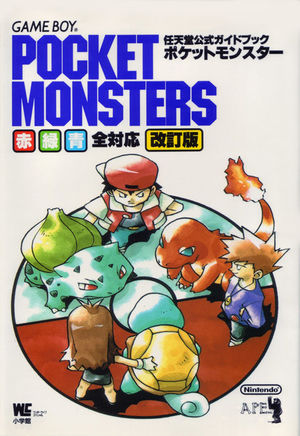
There were originally plans for a female protagonist as suggested by the artwork on the cover of the official guidebook for Pokémon Red and Green and Pokémon Blue. Green from Pokémon Adventures seems to be based on her. The character was redesigned and included in the remakes of the games, to continue the standard of including a female protagonist.
No Mew present
According to the interview by Satoru Iwata with Tsunekazu Ishihara and Shigeki Morimoto about the release of Pokémon HeartGold and SoulSilver, localized as Iwata Asks, they admitted that after the debugging tools were removed, they added Mew in the remaining space on the ROM. Nintendo thought that this would have been risky because altering the internal data after completing the testing period meant that any new bugs and/or glitches created by adding data without referring to debugging tools would have been much harder to fix. Standard programming practices usually discourage altering the source code and not testing it just before releasing the software to the customer.[6]
Poké Balls
- Main article: Poké Ball
Some concept art depicts Poké Balls on the ground, in two pieces. This is most likely just a carryover from when Pokémon was still the concept of Capsule Monsters. Strangely, the original Poké Ball sprites from Pokémon Red and Green lack the button in the center of the Poké Ball.
Rebattling Trainers
In an interview with Shōko Nakagawa in her book Shōko Nakagawa: Pokémon Taught Me The Meaning of Life, Tsunekazu Ishihara revealed that originally, the game was programmed to trigger a battle with each Trainer any time the player walked by them, regardless if the player had already defeated them in battle previously. The wild Pokémon encounter rate was also significantly higher originally. The Trainer rebattling was omitted from the final release and the wild Pokémon encounter rate was significantly reduced.[7]
Concept art
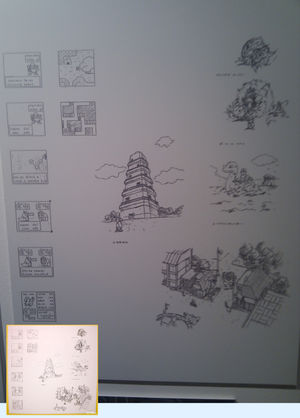
During a gaming exhibition called Game On, early concept art of Pokémon Red and Green by Ken Sugimori was featured, along with pre-release material from Pokémon Ruby and Sapphire. The concept art depicts rough versions of various concepts that made it into the final releases of the Generation I games. They seem to include various battles, the Safari Zone, Red riding on a Lapras, a Blastoise, Celadon City, Silph Co., and a town with a fountain which could have been reworked into Celadon City. Some other Pokémon are identifiable in a raw or semi-normal form, such as Gastly and others are prototypical of an entire class of Pokémon, such as a basic Dragon-type.
GameCenter CX

|
This section is incomplete. Please feel free to edit this section to add missing information and complete it. Reason: Expand based on the information provided by Satoshi Tajiri, if applicable |
A Japan-exclusive special Pokémon episode of GameCenter CX, known as Retro Game Master outside of Japan, included an interview with Satoshi Tajiri, where he revealed early Pokémon character profiles of Nidoking, Slowbro and Kadabra. Notably, they are given a National Pokédex number which matches their internal index number, rather than their final Kanto Pokédex number. Nidoking, for instance is noted as being #007, rather than #034, either suggesting that there was another method of ordering the Pokémon proposed, or that they reflect their ordering in the internal data. The latter is supported by interviews with Ken Sugimori, which verify that Rhydon, which has an index number of 001, was the first Pokémon ever created, and early sketches from Capsule Monsters featuring Rhydon. Nidoking is also referred to as マイコー♂ Maikō♂, indicating that there were either placeholder or alternate names for Pokémon before the development of Pokémon Red and Green had finished.
In addition to this, it was confirmed in an interview with Shigeki Morimoto that there were originally going to be 190 Pokémon in Generation I, indicating that the 39 Missingno. found in the internal index are formatted Pokémon.[8]
Sprites
Different front sprites of Pokémon were planned for Pokémon Blue, notably the ones for Raticate, Rhydon, Ditto, Dragonair and Mewtwo. These were featured in the November 1996 issue of CoroCoro Comic, which published general information about the game.[9]
As Red and Blue
Pokémon names
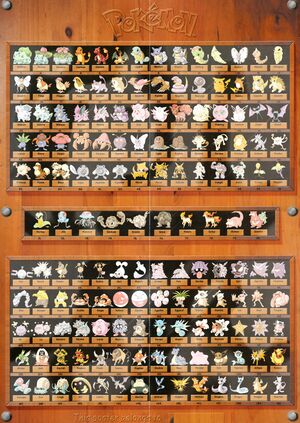
During the promotional period that preceded the English release of both the anime and Pokémon Red and Blue, a large amount of Pokémon were shown with different names from those they had in the final releases. Some of these names were similar to their final names, but some were quite close to their Japanese names, and others were completely different from any current Pokémon name.
| # | Final name | Early name | Japanese name | |
|---|---|---|---|---|
| 014 | 
|
Kakuna | Kokoon | Cocoon |
| 016 | 
|
Pidgey | Pidge | Poppo |
| 018 | 
|
Pidgeot | Pidgeott | Pigeot |
| 019 | 
|
Rattata | Rattatak | Koratta |
| 023 | 
|
Ekans | Arbo/"Nagahis" | Arbo |
| 024 | 
|
Arbok | Nagaasp | Arbok |
| 028 | 
|
Sandslash | Sandstorm | Sandpan |
| 035 | 
|
Clefairy | Aria | Pippi |
| 036 | 
|
Clefable | Ariala | Pixy |
| 037 | 
|
Vulpix | Foxfire | Rokon |
| 038 | 
|
Ninetales | Ninetai | Kyukon |
| 039 | 
|
Jigglypuff | Pudding | Purin |
| 040 | 
|
Wigglytuff | Custard | Pukurin |
| 043 | 
|
Oddish | Ladish | Nazonokusa |
| 046 | 
|
Paras | Parasyte | Paras |
| 050 | 
|
Diglett | Digda | Digda |
| 058 | 
|
Growlithe | Flamie | Gardie |
| 059 | 
|
Arcanine | Blaze | Windie |
| 060 | 
|
Poliwag | Aqua | Nyoromo |
| 061 | 
|
Poliwhirl | "Aquanau" | Nyorozo |
| 062 | 
|
Poliwrath | "Aquamar" | Nyorobon |
| 063 | 
|
Abra | Hocus | Casey |
| 064 | 
|
Kadabra | Pocus | Yungerer |
| 066 | 
|
Machop | Kara-tee | Wanriky |
| 067 | 
|
Machoke | Kung-foo | Goriky |
| 068 | 
|
Machamp | Ju-doh | Kairiky |
| 072 | 
|
Tentacool | Jilly | Menokurage |
| 073 | 
|
Tentacruel | Man O War | Dokukurage |
| 078 | 
|
Rapidash | Gallop | Gallop |
| 079 | 
|
Slowpoke | Slowmo | Yadon |
| 081 | 
|
Magnemite | Coil | Coil |
| 082 | 
|
Magneton | Recoil | Rarecoil |
| 083 | 
|
Farfetch'd | Fowler | Kamonegi |
| 084 | 
|
Doduo | Dodo | Dodo |
| 087 | 
|
Dewgong | Manaty | Jugon |
| 092 | 
|
Gastly | Spirit | Ghos |
| 093 | 
|
Haunter | Spectre | Ghost |
| 094 | 
|
Gengar | Phantom | Gangar |
| 096 | 
|
Drowzee | Sleeper | Sleep |
| 099 | 
|
Kingler | Kingle | Kingler |
| 102 | 
|
Exeggcute | "Eggstre" | Tamatama |
| 103 | 
|
Exeggutor | "Eggscut" | Nassy |
| 104 | 
|
Cubone | Orphon | Karakara |
| 105 | 
|
Marowak | Guardia | Garagara |
| 106 | 
|
Hitmonlee | Lee | Sawamular |
| 107 | 
|
Hitmonchan | Chan | Ebiwalar |
| 108 | 
|
Lickitung | Tonguetyd | Beroringa |
| 109 | 
|
Koffing | Ny | Dogars |
| 110 | 
|
Weezing | La | Matadogas |
| 113 | 
|
Chansey | Lucky | Lucky |
| 114 | 
|
Tangela | Meduza/Medusa | Monjara |
| 118 | 
|
Goldeen | Goldy | Tosakinto |
| 119 | 
|
Seaking | Neptune | Azumao |
| 123 | 
|
Scyther | Stryke | Strike |
| 130 | 
|
Gyarados | Skulkraken | Gyarados |
| 131 | 
|
Lapras | Ness | Laplace |
| 132 | 
|
Ditto | Morpho | Metamon |
| 133 | 
|
Eevee | Eon | Eievui |
| 137 | 
|
Porygon | Poregon | Porygon |
| 138 | 
|
Omanyte | Ess | Omnite |
| 139 | 
|
Omastar | Kargo | Omstar |
| 140 | 
|
Kabuto | Att | Kabuto |
| 141 | 
|
Kabutops | Lantis | Kabutops |
| 142 | 
|
Aerodactyl | Ptera | Ptera |
| 147 | 
|
Dratini | Dragoon | Miniryu |
| 148 | 
|
Dragonair | Dragyn | Hakuryu |
Text
Before the English releases of Pokémon Red and Blue, screenshots were released of a battle with the rival where the text string "The Blue wants to fight!" was used. While this text would work with a typical Trainer, such as "The Lass wants to fight!" or "The Hiker wants to fight!", as they were not given personal names until Generation II, it would cause problems with Gym Leader, Elite Four, rival, and link battles, leaving them to end up as "The Misty wants to fight!" or "The Lance wants to fight!", as these Trainers did not at the time have titles, only their names. Because of this, the definite article The was dropped in the final releases, leading to the somewhat odd sentence style in Generations I and II of:
A screenshot in the instruction manual and player's guide of English Red and Blue still contains the text "The Brock wants to fight!", possibly suggesting a late removal. The instruction manual also mentions Pokémon Leaders instead of Gym Leaders.
A slightly different grammar was also going to be used for other text strings.
- "{Player} sent {Pokémon} out!" instead of "{Player} sent out {Pokémon}!"
- "A wild {Pokémon} appeared!" became just "Wild {Pokémon} appeared!" (this change would be reverted in Pokémon Diamond and Pearl, where it has been kept since then)
- Similarly, "The enemy {Pokémon} fainted!" became simply "Enemy {Pokémon} fainted!" (also reverted in Diamond and Pearl as the definite article The was reinstated)
On page 31 of Nintendo Player's Guide for Pokémon Red and Blue, a different text string for using Cut on a tree on the overworld was used. It reads "Oddish Cut down a bush!", being used in a screenshot when cutting down the tree next to the Vermilion City Gym. The fact that Cut can also be used to destroy areas of tall grass may have been the reason for the change to "{Pokémon} hacked away with Cut!" in the final releases.
Pokémon Red has VRAM tileset data for Green. Pokémon Blue lacks any equivalent data for Red, however.[10]
Reception
The games received positive reviews from the press, receiving a perfect 10/10 "Masterful" rating from IGN.[11] The games received an average score of about 89% on GameRankings,[12] the second highest on the site for a core series Pokémon game, and the 3rd and 4th best score for a Game Boy title.[13]
Criticism
While bringing Pokémon to international fame and continuing the legacy of the Japanese Red and Green, Pokémon Red and Blue have been met with much criticism, especially compared to more recent releases in the series. Aside from the number of glitches present in the games, many Pokémon look very little like their appearance in the anime, which premiered nearly simultaneous with the games' North American release, or later games, which improved on several other aspects as well as the graphics.
The two games are also notorious for their several drastic glitches, among them the fabled Missingno., Glitch City, and the Mew glitch. Despite this, the glitches are arguably minimal points of criticism due to the reward value that comes from their activation, such as the multiplication of a player's sixth item that happens when Missingno. is encountered.
| Koffing's Red and Blue sprite | Koffing's Generation V sprite |
Soundtrack
- Main article: Game Boy: Entire Pokémon Sounds Collection CD
The soundtrack release for Pokémon Red, Green, and Blue also applies to Pokémon Red and Blue.
Staff
- Main article: Staff of Pokémon Red and Blue
Trivia
- The American staff in charge of localizing the games tried to change the Pokémon designs; however, Tsunekazu Ishihara refused the proposal.[14]
- The blurb on the back of the boxes states that 139 different Pokémon can be obtained in each game without trading. This, however, includes all Pokémon that the player must choose between (i.e., both the Omanyte and Kabuto families are counted). Therefore, the true total of different Pokémon obtainable in one adventure without trading is 124, which excludes the two unchosen starter families, one Fossil family, two Eeveelutions, one of Hitmonlee and Hitmonchan, and the four Pokémon that only evolve when traded.
- According to the Pokémon Pokédex Collector's Edition (Prima's Official Pokémon Guide), Red and Blue were developed by a team of nine members.
- Pokémon.com[15] and the Nintendo World Store[16] exhibit erroneously list the release date of Pokémon Red and Blue as September 30, 1998. The game was actually released on September 28, 1998.[1]
- Because the script for Pokémon Blue, rather than that of Pokémon Red and Green, was used for the translation of the Japanese trio into Pokémon Red and Blue, translation errors were made for two of the in-game trades.
- The old man who trades the player an Electrode on Cinnabar Island claims that the Raichu he received "went and evolved". As Raichu does not have an evolved form, this is not possible. In the context of Pokémon Blue, it makes sense as the player trades away a Kadabra, which evolves through trade, for a Graveler.
- The old man that trades the player a Jynx in Cerulean City claims that the Poliwhirl he received "went and evolved". While Poliwhirl does evolve, it does not evolve by trade in Generation I but rather through the use of a Water Stone. In the context of Pokémon Blue, the old man trades away a Haunter for a Machoke, which does evolve through trade.
- An error made during development causes the Pokémon depicted during Professor Oak's introductory lecture to be a Nidorino but with the cry of a Nidorina. This was already the case in the Japanese Red, Green, and Blue.
In other languages
| ||||||||||||||||||
See also
References
- ↑ 1.0 1.1 1.2 Game Boy's Pokémon Unleashed on September 28! (archive)
- ↑ 2.0 2.1 Pokémon™ Red Version and Pokémon™ Blue Version | Video Games | Pokemon.com (UK)
- ↑ 3.0 3.1 Pokémon Red Version | Game Boy | Games | Nintendo
- ↑ 4.0 4.1 Pokémon Blue Version | Game Boy | Games | Nintendo
- ↑ Anime News Network - (Pokemon TV)
- ↑ Iwata Asks - Pokémon HeartGold Version & SoulSilver Version
- ↑ Dogasu's Backpack: Nakagawa Shouko "Pokemon Taught Me the Meaning of Life"
- ↑ There Were 190 Pokémon! | Smogon Forums
- ↑ 2012-06-01 - ポケモンのおっさん
- ↑ Pokémon Red and Blue - The Cutting Room Floor
- ↑ IGN: Pokemon Blue Version (Pokemon Blue) (retrieved December 21, 2009)
- ↑ Pokemon Red Version for Game Boy - GameRankings (retrieved December 21, 2009)
- ↑ Reviews and News Articles - GameRankings (retrieved December 21, 2009)
- ↑ スペシャル対談/3
- ↑ Pokémon™ Red Version and Pokémon™ Blue Version | Video Games | Pokemon.com (USA)
- ↑ Nintendo - Nintendo World Pokémon Series Showcase (YouTube)

|
This game-related article is part of Project Games, a Bulbapedia project that aims to write comprehensive articles on the Pokémon games. |























